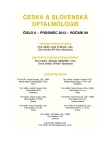Treatment Strategy of the Lacrimal Drainage System Inborn Obstruction. Part One – Conservative and Intervention Procedures
Authors:
J. Pokorná; R. Brunnerová; J. Krásný
Authors‘ workplace:
Oční klinika FN Královské Vinohrady, Praha přednosta prof. MUDr. P. Kuchynka, CSc.
Published in:
Čes. a slov. Oftal., 69, 2013, No. 6, p. 239-242
Category:
Original Article
Overview
The authors evaluated the successfulness of the conservative and intervention therapies combination in inborn lacrimal drainage system obstruction in a study group of 728 infants with 1154 eyes involved, treated at the Department of Ophthalmology, Faculty Hospital Královské Vinohrady (King’s Vineyards), Charles University, Prague, Czech Republic, E.U., during the period May 2004 – January 2011. The Fluoresceine Dye Dilution Test (FDDT) was used as the basic diagnostic test for the choice of the treatment procedure. The conservative therapy by itself, consisting of hydrostatic massages and application of germicide drops was helpful to canalize the lacrimal drainage system in 20 % of treated eyes, mostly in patients up to two months of age. The most of the patients (980 involved eyes), reached the Children outpatient’s of the Department of Ophthalmology at the age of approximately three months (average, 2.8 months). Since this age, the combination of the therapeutic irrigation with the probing, followed by the hydrostatic massages was indicated. The authors modified the probing technique according to their own experience gained during the endonasal intubation of the lacrimal drainage system by means of silicone tubing. At the phase of Bowman’s probe entering the nasolacrimal sac, the probe was turned under the angle of 45 degrees to the vertical axis of the nose with simultaneous pressuring the probe against the orbital margin. By this procedure, the probe was introduced into the medial nasal meatus in the region of maxillary uncinate processus. Up to the end of the sixth month of age of the followed up infants, using the combination of conservative and intervention procedures, the lacrimal drainage system of 1036 eyes (90 %) was canalized. Out of 118 eyes with stenosis remaining even after 6 months of age, using the above-mentioned conservative therapy until the age of one year, 96 lacrimal drainage systems were further canalized. In the remaining 22 eyes (2 %) after the age of 1 year, the intubation of the lacrimal drainage system using the silicone tubing was performed. The total successfulness of our conservative intervention treatment strategy of lacrimal drainage system inborn obstruction up to the age of one year was 98 %.
Key words:
hydrostatic massages, fluoresceine dye dilution test (FDDT), lacrimal drainage system irrigation, lacrimal drainage system probing, lacrimal drainage system inborn obstruction
Sources
1. Adenis et al.: Letude clinique et therapeutique des obstructions des voies lacrymales du nourrison, A propos de 152 cas. Bull Soc Oph France, 1981; 11: 892–894.
2. Andres, M.: Některé problémy překážek odtoku slz a jejich léčení. Čs Oftal, 36, 1980: 202–209.
3. Andres, M., Rozsíval, P.: Léčení uzávěru ductus lacrimalis v kojeneckém věku a malých dětí. Čs Oftal, 1988; 44: 434–434.
4. Boger, W.P.: Congenital Nasolacrimal Duct Obstruction. In Albert, D,M. and Jacobiec, F.A.: Principes and Practice of Ophthalmology, W. B. Saunders Co., Philadelphia, 1994, p. 2812–2826.
5. Cassidy, J.V.: Dacryocystitis of Infancy. Am J Ophthalmol, 1948; 31: 773–780.
6. Deyl, J.: Zevní choroby oční. Dr. E. Gregr a syn, Praha, 1927, s. 100.
7. Guerry, D. III., Kanding, E.L.: Congenitel Impotency of the Nasolacrinal Duct. Arch Ophthalmol, 1948; 39: 193–204.
8. Hurwitz, J.: The Lacrimal system., 1 st ed., Philadelphia: Lippincott Raven Publ., 1996, 331 pp.
9. Klika, E.: Embryologie, 1. vyd. Avicenum, Praha, 1983, 364 s.
10. Komínek, P., Červenka, S.: Nemoci slzných cest, diagnostika a léčba, 1. vyd. Maxdorf s.r.o., Praha, 2003, 287 s.
11. Krásný, J., Novák, V.: Kanylace vrozené neprůchodnosti slzných cest. Čes a Slov Oftal, 1997; 53: 117–121.
12. Kurz, J.: Základy očního lékařství, SZN, Praha, 1959, s. 159.
13. Kushner, B.: Congenital Nasolacrimal System Obstruction. Arch Ophthalmol, 1982; 100: 597–600.
14. Mc Ewen, C., Younr, J.: Epiphora During the First Year of Life. Eye, 5, 1991: 596–600.
15. Moscato, E., Kelly, J.: Developmental Anatomy of the Nasolacrimal Duct: Implications for Congenital Obstruction. Ophthalmology, 2010; 117: 2430–2434.
16. Odehnal, M., Kozáková, V.: Časový faktror a instrumentální léčba neprůchodnosti slzných cest v dětském věku. Čes a Slov Oftal, 2001; 57: 193–199.
17. Paul, T.: Medical Managemant of Congenital Obstruction of the Nasolacrimal duct. J Pediatr. Ophthalmol, 1978; 15: 246–250.
18. Pokorná, J., Laštovička, P., Krásný, J.: Nový typ kanylace slzných cest batolat. Fol Strabol Neurol, 2010; 9, suppl. I: 62–64.
19. Pokorná, J., Syslová Chvojková, J., Laštovička, P., Krásný, J. : Strategie léčby vrozené neprůchodnosti slzných cest (II. část – Endonasální intubace silikonovými kanylami), připravováno do tisku.
20. Puvanachandra, N., Trikha, S., A.: National Survey of the Management of Congenital Nasolacrimal Duct Obstruction in the United Kingdom. J Pediatr Ophthalmol Strabismus, 2010; 47: 75.
21. Řehůřek, J., Holoušková, M.: Optimalizace léčebného postupu při neprůchodnosti slzných cest u novorozenců a kojenců. Čes a Slov Oftal, 1997; 53: 381–384.
22. Řehůřková, M.: Dutá sonda v diagnostice a terapii onemocnění slzných cest. Čes Oftal, 1978; 34: 105–107.
23. Sevel, D.: Development and Congenital Abnormalities of Nasolacrimal Apparatus. J Pediatr Ophthalmol Strab, 1981; 18: 13–19.
24. Stager, D., Baker, J., Frey, T., et al.: Office Probing of Congenital Nasolacrimal Duct Obstruction. Ophthalmic Surg, 1992; 23: 482–484.
25. Sturrock, S.M., Mc Eewen, C.J., Young, J.D.: Long Term Result after Probing for Congenital Duct Obstruction. Br J Ophthalmol, 1994; 78: 892–94.
26. Zappia, R.J., Milder, B.: Lacrimal Drainage Function: 2. The Fluoresecein Dye Disappearence Test. Am J Ophthalmol, 1972; 74: 160–163.
Labels
OphthalmologyArticle was published in
Czech and Slovak Ophthalmology

2013 Issue 6
Most read in this issue
- Vision Loss after Uncomplicated Pars Plana Vitrectomy
- Treatment Strategy of the Lacrimal Drainage System Inborn Obstruction. Part One – Conservative and Intervention Procedures
- Cytomegalovirus Retinitis in HIV Negative Patients – Retrospective Study
- Pars Plana Vitrectomy Due to the Intravitreal Hemorrhage Caused by Persistent Hyaloid Artery in Three Children
